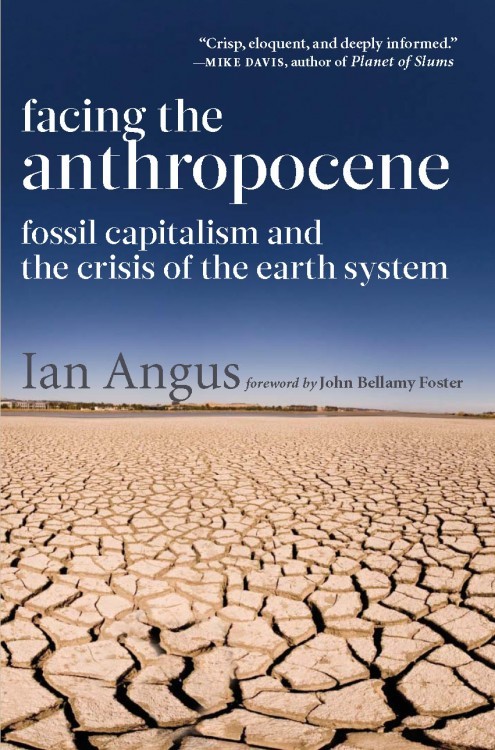

Subscribe to
MONTHLY
REVIEW!
MONTHLY
REVIEW
ONLINE
ARCHIVE
for Subscribers
Buy directly
from the
MR STORE
and support
MONTHLY
REVIEW!

RSS
Subscribe to MRZine
MRZINE
ARCHIVE
SEARCH
SUBMISSIONS
CONTACT


FACING THE ANTHROPOCENE:
Fossil Capitalism and the Crisis of the Earth System
by Ian Angus
MARX'S ECOLOGY:
Materialism and Nature
by John Bellamy Foster
WHAT EVERY ENVIRONMEN-
TALIST NEEDS TO KNOW ABOUT CAPITALISM
by Fred Magdoff and John Bellamy Foster
THE ECOLOGICAL RIFT:
Capitalism's War on the Earth
by
John Bellamy Foster, Brett Clark, and Richard York
AGRICULTURE AND FOOD IN CRISIS:
Conflict, Resistance, and Renewal
by Fred Magdoff and Brian Tokar
HUNGRY FOR PROFIT:
The Agribusiness Threat to Farmers, Food, and the Environment
edited by Fred Magdoff, John Bellamy Foster, and Frederick H. Buttel
CRITIQUE OF INTELLIGENT DESIGN:
Materialism versus Creationism from Antiquity to the Present
by John Bellamy Foster, Brett Clark, and Richard York
THE SCIENCE AND HUMANISM OF STEPHEN JAY GOULD
by Richard York and Brett Clark
BIOLOGY UNDER THE INFLUENCE:
Dialectical Essays on Ecology, Agriculture, and Health
by Richard Lewontin and Richard Levins

SILVERTOWN:
The Lost Story of a Strike that Shook London and Helped Launch the Modern Labor Movement
by John Tully
THE DEVIL'S MILK:
A Social History of Rubber
by John Tully

KILLING ME SOFTLY:
Toxic Waste, Corporate Profit, and the Struggle for Environmental Justice
by Eddie J. Girdner and Jack Smith 
THE NECESSITY OF SOCIAL CONTROL
by István Mészáros
BEYOND CAPITAL:
Toward a Theory of Transition
by István Mészáros
by Ian Angus
Key conclusion of Anthropocene Working Group report to Geological Congress: the "Great Acceleration" in the second half of the 20th century marked the end of the Holocene and the beginning of a new geological epoch.
The evidence is overwhelming: earth entered a new geological epoch in about 1950. In an official report to the International Geological Congress, the Anthropocene Working Group made that case, and proposed to move towards official adoption in the next 2-3 years.
Colin Waters, secretary of the AWG, told the press: "Being able to pinpoint an interval of time is saying something about how we have had an incredible impact on the environment of our planet. The concept of the Anthropocene manages to pull all these ideas of environmental change together."
All but one of the AWG's 35 members agree that the Anthropocene is "stratigraphically real" (one abstained) and 30 agree (2 opposed, 3 abstentions) that the new epoch should be formally added to the Geological Time Scale.

If approved, the Anthropocene would become
the newest epoch in the Quaternary Period.
The AWG will now shift its focus to identifying a global "signal" that coincides with the change. Ten of the AWG's members favor using plutonium fallout from nuclear tests as the signal, but there are many other possibilities. Once a signal is agreed on, they will determine a "golden spike" (properly, a "Global Boundary Stratotype Section and Point") -- an actual location in rock, sediment, or ice strata, somewhere on earth, that would physically define the onset of the new epoch.
Once the AWG has agreed, it will initiate a formal approval process, which requires 60% approval by the International Commission on Stratigraphy and the Executive Committee of the International Union of Geological Sciences before the Anthropocene is added to the Geological Time Scale.
Formal approval is not automatic -- the ICS and the IUGS are conservative bodies and can take years to act -- but there is now no doubt that the Anthropocene is real and it is here to stay.
The following summary was released just before Dr. Colin Waters of the British Geological Survey began presenting the AWG's report to the International Geological Congress on Monday, August 29.
|
Majority current opinion on the group indicates the following:
Results of AWG Vote (35 members):
|
Ian Angus is editor of the ecosocialist journal Climate & Capitalism. He is co-author, with Simon Butler, of Too Many People? Population, Immigration and the Environmental Crisis (Haymarket, 2011), and editor of the anthology The Global Fight for Climate Justice (Fernwood, 2010). His latest book is Facing the Anthropocene: Fossil Capitalism and the Crisis of the Earth System (Monthly Review Press, 2016). This article also appears in Climate and Capitalism today.
